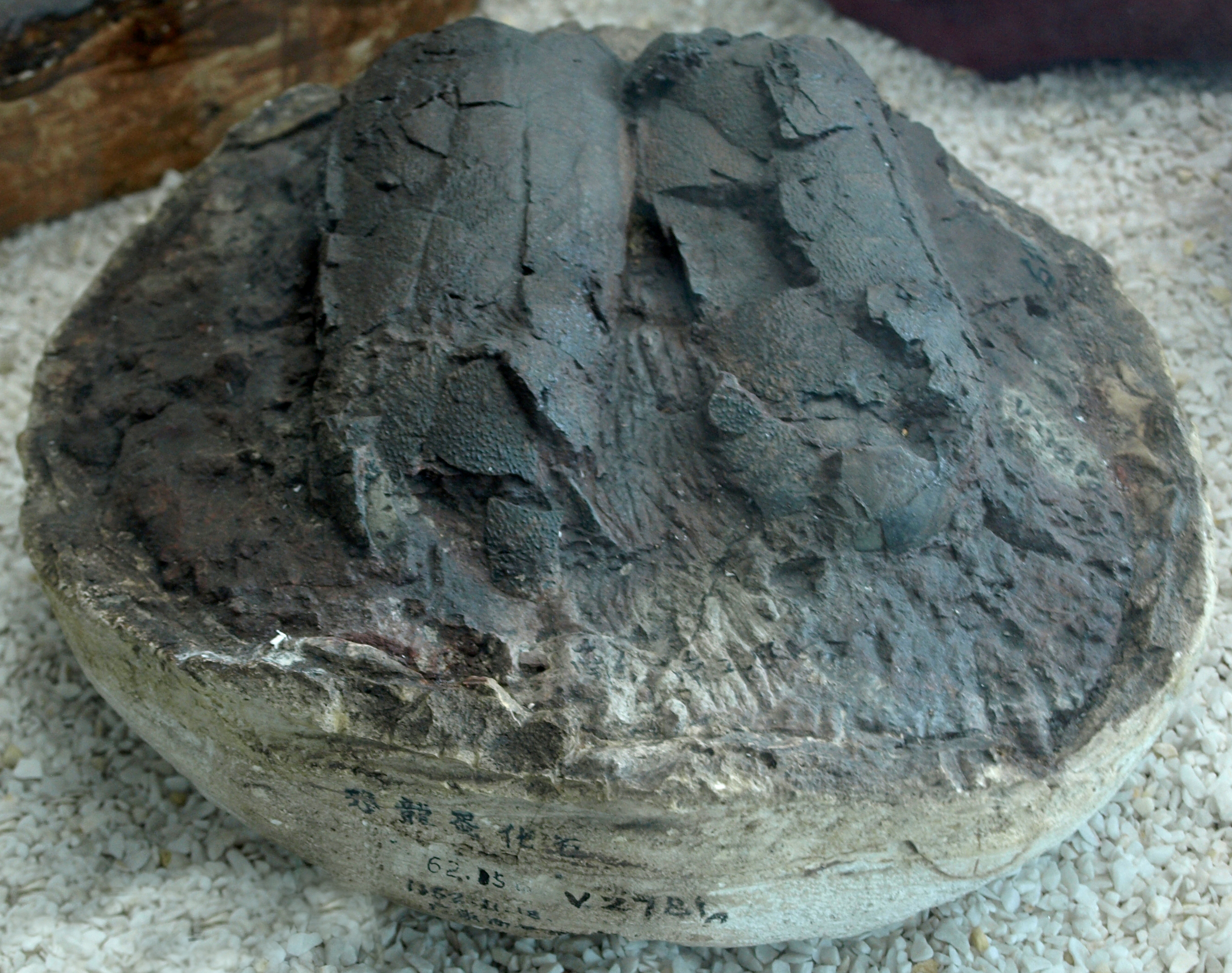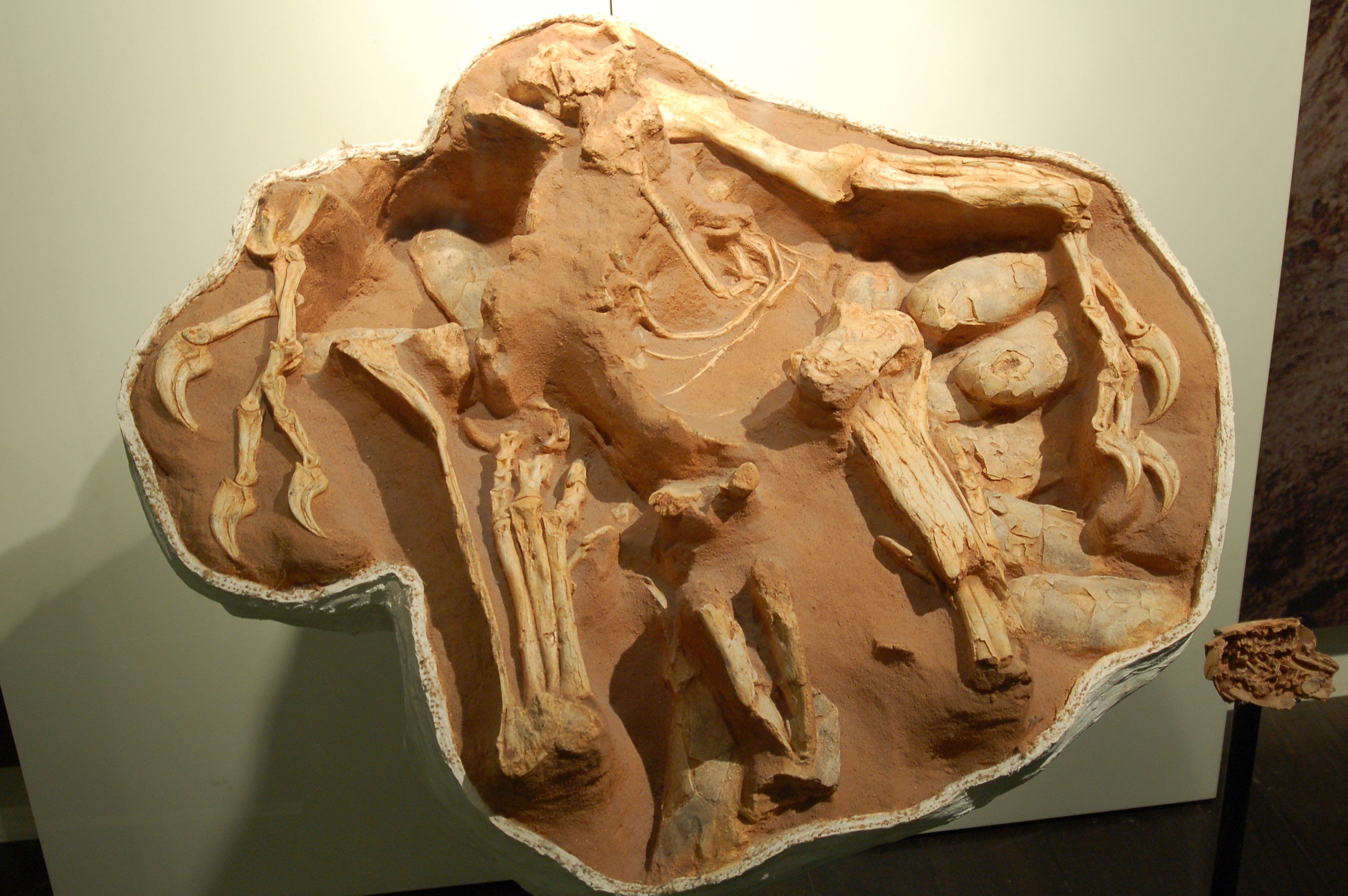|
Elongatoolithus
''Elongatoolithus'' is an oogenus of dinosaur eggs found in the Late Cretaceous formations of China and Mongolia. Like other elongatoolithids, they were laid by small theropods (probably oviraptorosaurs), and were cared for and incubated by their parents until hatching. They are often found in nests arranged in multiple layers of concentric rings. As its name suggests, ''Elongatoolithus'' was a highly elongated form of egg. It is historically significant for being among the first fossil eggs given a parataxonomic name. Description ''Elongatoolithus'' eggs are small to midsized eggs, with a maximum size of about . The eggs are highly elongated, typically being 2 to 2.2 times longer than they are wide, and slightly asymmetric (with one end pointier than the other). The outer surface of their shells is ornamented with a fine pattern of nodes and ridges, either aligned parallel to the egg's long axis (lineartuberculate ornamentation) or in irregular chains (ramotuberculare ornamentat ... [...More Info...] [...Related Items...] OR: [Wikipedia] [Google] [Baidu] |
Macroolithus
''Macroolithus'' is an oogenus (fossil-egg genus) of dinosaur egg belonging to the oofamily Elongatoolithidae. The type oospecies, ''M. rugustus'', was originally described under the now-defunct oogenus name ''Oolithes''. Three other oospecies are known: ''M. yaotunensis'', ''M. mutabilis'', and ''M. lashuyuanensis''. They are relatively large, elongated eggs with a two-layered eggshell. Their nests consist of large, concentric rings of paired eggs. There is evidence of blue-green pigmentation in its shell, which may have helped camouflage the nests. ''Macroolithus'' eggs have been found containing oviraptorid dinosaur embryos resembling ''Heyuannia''. Multiple other associations between oviraptorid and elongatoolithids (including other eggs containing embryos, parents brooding on nests, and a pair of shelled ''Macroolithus''-like eggs preserved within an oviraptorid's pelvis) confirm that the parent of ''Macroolithus'' was an oviraptorid. It is found in Upper Cretaceous format ... [...More Info...] [...Related Items...] OR: [Wikipedia] [Google] [Baidu] |
Elongatoolithidae
Elongatoolithidae is an oofamily of fossil eggs, representing the eggs of oviraptorosaurs (with the exception of the avian '' Ornitholithus''). They are known for their highly elongated shape. Elongatoolithids have been found in Europe, Asia, and both North and South America.Simon, D. J. (2014).Giant Dinosaur (theropod) Eggs of the Oogenus Macroelongatoolithus (Elongatoolithidae) from Southeastern Idaho: Taxonomic, Paleobiogeographic, and Reproductive Implications. (Doctoral dissertation, Montana State University, Bozeman). Distribution Elongatoolithids have a very broad distribution. They have been found across Asia and the US, as well as in Spain, France, and Argentina, with ages ranging from lower Cretaceous to the Paleocene. Description Elongatoolithids are, as their name suggests, highly elongated eggs; they are at least twice as long as they are wide. They vary widely in size, ranging from the 7 cm long ''Elongatoolithus chichengshanensis'' to the gigantic 60 cm ' ... [...More Info...] [...Related Items...] OR: [Wikipedia] [Google] [Baidu] |
Elongatoolithid
Elongatoolithidae is an oofamily of fossil eggs, representing the eggs of oviraptorosaurs (with the exception of the avian '' Ornitholithus''). They are known for their highly elongated shape. Elongatoolithids have been found in Europe, Asia, and both North and South America.Simon, D. J. (2014).Giant Dinosaur (theropod) Eggs of the Oogenus Macroelongatoolithus (Elongatoolithidae) from Southeastern Idaho: Taxonomic, Paleobiogeographic, and Reproductive Implications. (Doctoral dissertation, Montana State University, Bozeman). Distribution Elongatoolithids have a very broad distribution. They have been found across Asia and the US, as well as in Spain, France, and Argentina, with ages ranging from lower Cretaceous to the Paleocene. Description Elongatoolithids are, as their name suggests, highly elongated eggs; they are at least twice as long as they are wide. They vary widely in size, ranging from the 7 cm long ''Elongatoolithus chichengshanensis'' to the gigantic 60 cm ' ... [...More Info...] [...Related Items...] OR: [Wikipedia] [Google] [Baidu] |
Nanhsiungoolithus
''Nanhsiungoolithus'' is an oogenus (fossil-egg genus) of dinosaur egg from the late Cretaceous of China. It belongs to the oofamily Elongatoolithidae, which means that it was probably laid by an oviraptorosaur, though so far no skeletal remains have been discovered in association with ''Nanhsiungoolithus''. The oogenus contains only a single described oospecies, ''N. chuetienensis''. It is fairly rare, only being know from two partially preserved nests and a few eggshell fragments. Description The type specimen of ''Nanhsiungoolithus'' is a partial nest containing three mostly complete eggs and impressions. Another partial nest preserves two whole eggs, two incomplete eggs, and two impressions. Like other elongatoolithids, the eggs are found arranged in a circular pattern. The eggs are long and narrow, with an average length of and width of . They are slightly asymmetrical, with one end slightly pointier than the other. ''Nanhsiungoolithus'' is distinctive for the smooth textu ... [...More Info...] [...Related Items...] OR: [Wikipedia] [Google] [Baidu] |
Protoceratops
''Protoceratops'' (; ) is a genus of small protoceratopsid dinosaurs that lived in Asia during the Late Cretaceous, around 75 to 71 million years ago. The genus ''Protoceratops'' includes two species: ''P. andrewsi'' and the larger ''P. hellenikorhinus''. The former was described in 1923 with fossils from the Mongolian Djadokhta Formation, and the latter in 2001 with fossils from the Chinese Bayan Mandahu Formation. ''Protoceratops'' was initially believed to be an ancestor of ankylosaurians and larger ceratopsians, such as ''Triceratops'' and relatives, until the discoveries of other protoceratopsids. Populations of ''P. andrewsi'' may have evolved into ''Bagaceratops'' through anagenesis. ''Protoceratops'' were small ceratopsians, about long and in body mass. While adults were largely quadrupedal, juveniles had the capacity to walk around bipedally if necessary. They were characterized by a proportionally large skull, short and stiff neck, and neck frill. The frill was likel ... [...More Info...] [...Related Items...] OR: [Wikipedia] [Google] [Baidu] |
Dinosaur Egg
Dinosaur eggs are the organic vessels in which a dinosaur embryo develops. When the first scientifically documented remains of non-avian dinosaurs were being described in England during the 1820s, it was presumed that dinosaurs had laid eggs because they were reptiles. In 1859, the first scientifically documented dinosaur egg fossils were discovered in France by Jean-Jacques Poech, although they were mistaken for giant bird eggs (birds were not yet recognized as dinosaurs at the time). The first scientifically recognized non-avian dinosaur egg fossils were discovered in 1923 by an American Museum of Natural History crew in Mongolia. Dinosaur eggshell can be studied in thin section and viewed under a microscope. The interior of a dinosaur egg can be studied using CAT scans or by gradually dissolving away the shell with acid. Sometimes the egg preserves the remains of the developing embryo inside. The oldest known dinosaur eggs and embryos are from ''Massospondylus'', which lived ... [...More Info...] [...Related Items...] OR: [Wikipedia] [Google] [Baidu] |
Oogenus
Egg fossils are the fossilized remains of eggs laid by ancient animals. As evidence of the physiological processes of an animal, egg fossils are considered a type of trace fossil. Under rare circumstances a fossil egg may preserve the remains of the once- developing embryo inside, in which case it also contains body fossils. A wide variety of different animal groups laid eggs that are now preserved in the fossil record beginning in the Paleozoic. Examples include invertebrates like ammonoids as well as vertebrates like fishes, possible amphibians, and reptiles. The latter group includes the many dinosaur eggs that have been recovered from Mesozoic strata. Since the organism responsible for laying any given egg fossil is frequently unknown, scientists classify eggs using a parallel system of taxonomy separate from but modeled after the Linnaean system. This "parataxonomy" is called ''veterovata''. History The first named oospecies was '' Oolithes bathonicae'', a name given provisi ... [...More Info...] [...Related Items...] OR: [Wikipedia] [Google] [Baidu] |
Djadokhta Formation
The Djadochta Formation (sometimes transcribed and also known as Djadokhta, Djadokata, or Dzhadokhtskaya) is a highly fossiliferous geological formation situated in Central Asia, Gobi Desert, dating from the Late Cretaceous period, about 75 million to 71 million years ago. The type locality is the Bayn Dzak locality, famously known as the Flaming Cliffs. Dinosaur, mammal, and other reptile remains are among the fossils that have been recovered from the formation. Excavation history The Djadochta Formation was first documented and explored—though only a single locality—during paleontological expeditions of the American Museum of Natural History in 1922–1925, which were part of the Central Asiatic Expeditions. The expeditions were led by Roy Chapman Andrews, in company of Walter Willis Granger as chief paleontologist and field team. The team did extensive exploration at the Bayn Dzak (formerly Shabarakh Usu) region, which they nicknamed Flaming Cliffs given that at sunset th ... [...More Info...] [...Related Items...] OR: [Wikipedia] [Google] [Baidu] |
Prismatoolithidae
Prismatoolithidae is an oofamily of fossil eggs. They may have been laid by ornithopods or theropod Theropoda (; ), whose members are known as theropods, is a dinosaur clade that is characterized by hollow bones and three toes and claws on each limb. Theropods are generally classed as a group of saurischian dinosaurs. They were ancestrally c ...s. References Egg fossils Dinosaur reproduction {{eggshell-stub ... [...More Info...] [...Related Items...] OR: [Wikipedia] [Google] [Baidu] |
Prismatoolithus
''Prismatoolithus'' is an oogenus of dinosaur egg from the Cretaceous (Hauterivian-Maastrichtian) and possibly also the earliest Paleocene. They likely belonged to troodontids Troodontidae is a clade of bird-like theropod dinosaurs. During most of the 20th century, troodontid fossils were few and incomplete and they have therefore been allied, at various times, with many dinosaurian lineages. More recent fossil discov ...Mateus, I, H Mateus, MT Antunes, O Mateus, P Taquet, V Ribeiro, G Manuppella. 1998. Upper Jurassic theropod dinosaur embryos from Lourinhã (Portugal). Memórias da Academia das Ciências de Lisboa 37, 101-110 References Dinosaur reproduction Egg fossils Fossils of Canada Paleontology in Alberta Fossils of China Fossils of France Fossils of Japan Fossils of Mexico Fossils of Morocco Fossils of Spain Tremp Formation Fossils of the United States Paleontology in Montana Paleontology in New Mexico Paleontology in Utah Milk River Formation Fos ... [...More Info...] [...Related Items...] OR: [Wikipedia] [Google] [Baidu] |
Yang Zhongjian
Yang Zhongjian, also Yang Chung-chien (; 1 June 1897 – 15 January 1979), courtesy name Keqiang (), also known as C.C. (Chung Chien) Young, was a Chinese paleontologist and zoologist. He was one of China's foremost vertebrate paleontologists. He has been called the "Father of Chinese Vertebrate Paleontology". Biography Yang was born in Hua County, Shaanxi, China. He graduated from the Department of Geology of Peking University in 1923, and in 1927 received his doctorate from the University of Munich in Germany. In 1928 he worked for the Cenozoic Research Laboratory of the Geological Survey of China and took charge of excavations at the Peking Man Site at Zhoukoudian. He held professorial posts at the Geological Survey of China, Peking University, and Northwest University in Xi'an. Yang's scientific work was instrumental in the creation of China's Institute of Vertebrate Paleontology and Paleoanthropology in Beijing, which today houses one of the most important collections of ... [...More Info...] [...Related Items...] OR: [Wikipedia] [Google] [Baidu] |
CosmoCaixa Barcelona
CosmoCaixa Barcelona () is a science museum located in Barcelona, Catalonia, Spain. Formerly known as the Science Museum of Barcelona, it closed for renovations in 1998 and reopened in 2004 under its current name. The museum features a variety of exhibitions, permanent and temporary, that showcase the environment, nature, science, and space. CosmoCaixa also has a planetarium and exhibitions devoted to interaction such as touch and play for small children. It also has a bookstore, gift shop, library, teaching center and cafe. The museum is sponsored by la Caixa. Entry to the museum is free for students under 16. Adults too can enjoy at the museum with an entry ticket of 6 euros. Building The building was built between 1904-1909 by Josep Domènech i Estapà to serve as an asylum for the blind which closed in 1979. The building was renovated, retaining the original facade, and an expansion took place bringing the building to four times its original size. An expansion of the build ... [...More Info...] [...Related Items...] OR: [Wikipedia] [Google] [Baidu] |




.jpg)

